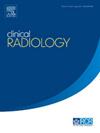A CT radiomics-based machine learning model for predicting high-grade pathological components in stage IA lung adenocarcinoma: a two-center study
IF 1.9
3区 医学
Q2 RADIOLOGY, NUCLEAR MEDICINE & MEDICAL IMAGING
引用次数: 0
Abstract
Aim
To explore the application value of a machine learning model based on CT radiomics in predicting high-grade components in clinical stage IA lung adenocarcinoma.
Materials and methods
A retrospective dataset of 405 patients with pathologically confirmed stage IA lung adenocarcinoma who underwent surgical resection at two hospitals was collected (156 cases in the HGC group and 249 cases in the non-HGC group). Radiomic features were extracted from each patient's gross tumor volume (GTV) and peritumoral volume (PTV). Lasso-SVM was employed to develop radiomics, clinical, and combined models in the training dataset. The models' performance and clinical utility were evaluated in both internal and external validation datasets using receiver operating characteristic (ROC) curves and decision curve analysis (DCA).
Results
A total of 12 GTV features, 9 PTV features, and 14 GPTV features were selected for building the model. The combined model incorporating radiomic features and the clinical feature achieved an area under the curve (AUC) value of 0.860 (95% CI: 0.809–0.912) in the training set, 0.849 (95% CI: 0.764–0.933) in the internal validation set, and 0.822 (95% CI: 0.730–0.914) in the external validation set.
Conclusion
Machine learning model based on CT radiomics are helpful in preoperatively identifying high-grade components in clinical stage IA lung adenocarcinoma.
基于CT放射组学的机器学习模型预测IA期肺腺癌的高级别病理成分:一项双中心研究
目的:探讨基于CT放射组学的机器学习模型在IA期肺腺癌高级别成分预测中的应用价值。材料与方法:回顾性收集两家医院病理证实的IA期肺腺癌手术切除患者405例(HGC组156例,非HGC组249例)。从每位患者的总肿瘤体积(GTV)和肿瘤周围体积(PTV)中提取放射学特征。使用Lasso-SVM在训练数据集中开发放射组学、临床和组合模型。采用受试者工作特征(ROC)曲线和决策曲线分析(DCA)在内部和外部验证数据集中评估模型的性能和临床效用。结果:共选择12个GTV特征、9个PTV特征和14个GPTV特征进行建模。结合放射学特征和临床特征的联合模型在训练集的曲线下面积(AUC)值为0.860 (95% CI: 0.809-0.912),在内部验证集的AUC值为0.849 (95% CI: 0.764-0.933),在外部验证集的AUC值为0.822 (95% CI: 0.730-0.914)。结论:基于CT放射组学的机器学习模型有助于术前鉴别临床期肺腺癌的高级别成分。
本文章由计算机程序翻译,如有差异,请以英文原文为准。
求助全文
约1分钟内获得全文
求助全文
来源期刊

Clinical radiology
医学-核医学
CiteScore
4.70
自引率
3.80%
发文量
528
审稿时长
76 days
期刊介绍:
Clinical Radiology is published by Elsevier on behalf of The Royal College of Radiologists. Clinical Radiology is an International Journal bringing you original research, editorials and review articles on all aspects of diagnostic imaging, including:
• Computed tomography
• Magnetic resonance imaging
• Ultrasonography
• Digital radiology
• Interventional radiology
• Radiography
• Nuclear medicine
Papers on radiological protection, quality assurance, audit in radiology and matters relating to radiological training and education are also included. In addition, each issue contains correspondence, book reviews and notices of forthcoming events.
 求助内容:
求助内容: 应助结果提醒方式:
应助结果提醒方式:


